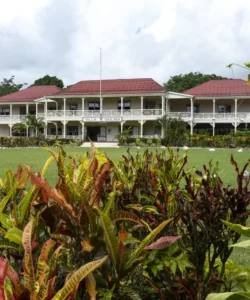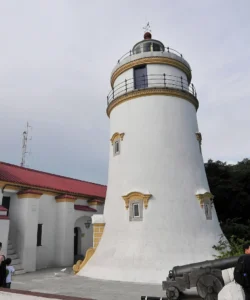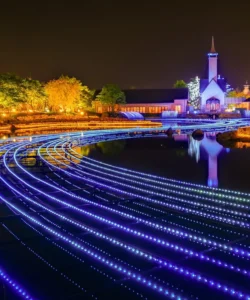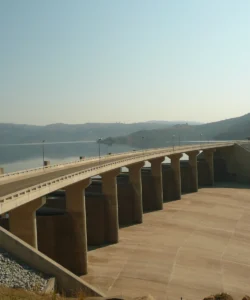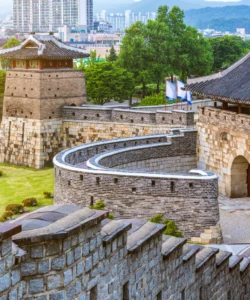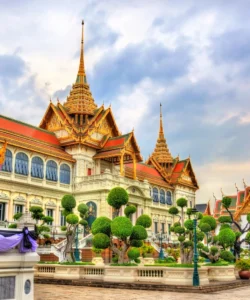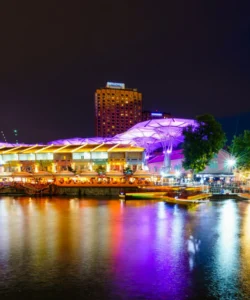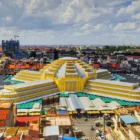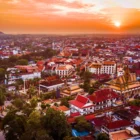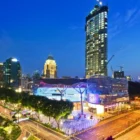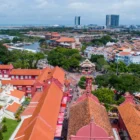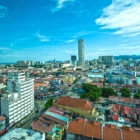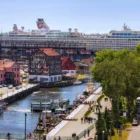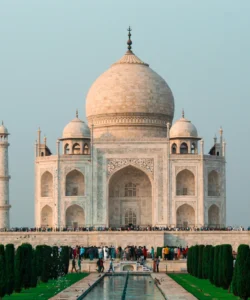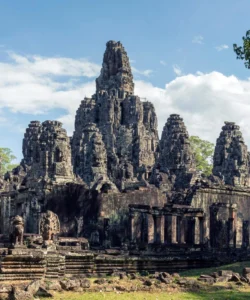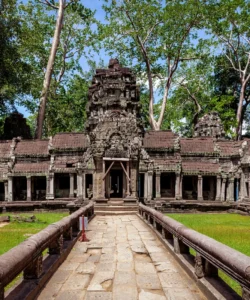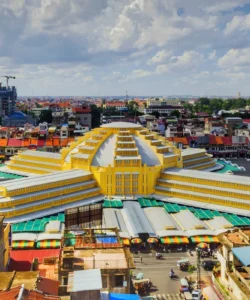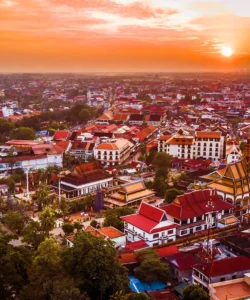Bayon Temple is one of the most distinctive and enigmatic temples within the vast Angkor Archaeological Park in Cambodia. Located at the very heart of Angkor Thom, the ancient walled capital city, it is renowned for its multitude of serene, smiling stone faces that gaze out from its towering spires, creating a truly unique and mystical atmosphere.
Name: Bayon Temple (Khmer: ប្រាសាទបាយ័ន, Prasat Bayoăn; originally known as Jayagiri or “Victory Mountain”)
Address: Bayon Temple is situated at the exact geographical center of Angkor Thom, the ancient capital city within the Angkor Archaeological Park. It is approximately 7 kilometers (4.3 miles) north of Siem Reap city, in Siem Reap Province, Cambodia.
How to Get There:
Access to Bayon Temple, like other temples in the Angkor Archaeological Park, is from Siem Reap, the main tourist hub.
- From Siem Reap City:
- Tuk-tuk (Recommended): This is the most popular and atmospheric way to visit. You can hire a tuk-tuk driver for a full day (or multiple days) to take you around the “Small Circuit” route, which prominently features Angkor Thom and Bayon. The drive from Siem Reap to Angkor Thom’s South Gate (the most common entrance to the city and Bayon) takes around 15-20 minutes.
- Taxi/Private Car with Driver: Offers more comfort and air-conditioning, especially useful in the heat. Easily arranged through hotels or local services.
- Bicycle/Electric Bike: Cycling is a viable option for fit individuals, as the roads within Angkor Thom are generally flat and well-paved.
- Ride-Hailing Apps (Grab, PassApp): Can be used to hire taxis or tuk-tuks.
- Angkor Pass: A valid Angkor Pass is required to enter Bayon and all other temples within the Angkor Archaeological Park. These can be purchased in 1-day, 3-day, or 7-day options from Angkor Enterprise (the official ticket office) or online. The pass is checked at the Angkor Thom gates and again at individual temples.
Landscape and Architecture:
Bayon Temple’s architecture is a complex and somewhat labyrinthine example of the “Baroque style” of Khmer art, deliberately breaking from the more classical symmetry of earlier temples like Angkor Wat.
- Multitude of Stone Faces: Bayon’s most distinctive and famous feature is the multitude of colossal, serene, and subtly smiling stone faces carved into the many towers that rise from its upper terrace. Originally, there were believed to be 49 to 54 towers, with estimates of over 200 to 216 faces. Today, about 37 towers with around 173 faces remain due to decay and alterations. Each face is approximately 4 meters high and gazes in the four cardinal directions.
- These faces are widely believed to represent Avalokiteshvara, the bodhisattva of compassion, a central figure in Mahayana Buddhism. However, many scholars also note their striking resemblance to King Jayavarman VII himself, suggesting a “god-king” concept where the monarch was seen as an embodiment of divine power.
- Central to Angkor Thom: Bayon sits at the exact center of the walled city of Angkor Thom (Great City), a sprawling complex that served as King Jayavarman VII’s capital. The city’s roads lead directly to Bayon from its four cardinal gates, emphasizing the temple’s central importance. Unlike most temples, Bayon itself does not have an outer wall or moat; these are provided by the city of Angkor Thom itself.
- Labyrinthine Structure: The temple’s layout is characterized by a complex, almost maze-like structure, with narrow corridors, steep stairways, hidden alcoves, and multiple levels. It can feel disorienting, adding to its mysterious appeal.
- Three Tiers/Galleries: Bayon is built on three main levels or tiers, with richly decorated galleries:
- Outer Gallery: Adorned with extensive bas-reliefs depicting scenes from everyday Khmer life, including market scenes, fishing, cockfights, and, most famously, historical events such as battles between the Khmer and the Cham (likely the Cham invasion of 1177 CE). These are highly detailed and offer a rare glimpse into the secular aspects of ancient Khmer life.
- Inner Gallery: Elevated above ground, its reliefs primarily illustrate scenes from Hindu mythology, featuring deities like Shiva, Vishnu, and Brahma.
- Upper Terrace: This level features the cluster of famous face towers and leads to the central sanctuary.
- Buddhist Temple (with Hindu Influences): Built in the late 12th or early 13th century under the reign of King Jayavarman VII, Bayon was the last state temple to be built at Angkor and the only one primarily dedicated to Mahayana Buddhism. However, it also incorporates Hindu deities and iconography, reflecting the religious shifts and syncretism of the era.
- Sandstone and Laterite Construction: Like other Angkorian temples, Bayon was primarily constructed from sandstone, meticulously carved and fitted together.
What Makes It Famous:
- The Enigmatic Smiling Faces: The multitude of colossal, serene, and mysterious smiling faces on its towers are Bayon’s defining feature and its primary claim to fame. These “Bayon smiles” are instantly recognizable and are considered masterpieces of Khmer sculpture.
- “Baroque” Style of Khmer Architecture: It represents a distinct departure from the classical style of Angkor Wat, embodying a “Baroque” period in Khmer architecture with its dense ornamentation, multi-towered structure, and more complex, less symmetrical layout.
- Located in the Heart of Angkor Thom: Its central position within the walled capital city of Angkor Thom makes it a pivotal and easily accessible part of the broader Angkor Archaeological Park experience.
- Rich Bas-Reliefs of Daily Life and History: The outer galleries’ bas-reliefs are exceptional for their depiction of secular life and historical events, offering a unique window into the social fabric and military might of the Khmer Empire, in addition to mythological narratives.
- Buddhist State Temple: As the state temple of a powerful Mahayana Buddhist king, it symbolizes a significant religious shift in the Khmer Empire and embodies a unique fusion of Buddhist and Hindu elements.
- Mystical and Immersive Atmosphere: The sheer number of faces, the labyrinthine passages, and the interplay of light and shadow create a deeply atmospheric and almost spiritual experience, often described as enigmatic or haunting.
- Part of UNESCO World Heritage Site: As a key component of the Angkor Archaeological Park, Bayon is part of a UNESCO World Heritage Site, recognized for its outstanding universal value.
Differences from Some Other Wonders:
- Multitude of Smiling Faces: This is the most profound distinction from all other temples. While other temples have statues or reliefs, Bayon’s hundreds of colossal, serene faces on its towers are absolutely unique and create an immersive visual experience.
- Buddhist State Temple (primarily): Unlike Angkor Wat (originally Hindu, later Buddhist) or Prambanan (Hindu), Bayon was built as a Mahayana Buddhist state temple, though it still incorporates Hindu elements, reflecting the distinct religious inclination of its builder, King Jayavarman VII.
- Labyrinthine Layout vs. Grand Symmetry: Compared to the grand, symmetrical, and open layout of Angkor Wat with its long causeways, Bayon is more compact, dense, and labyrinthine, encouraging a more intimate and exploratory experience through its narrow passages and stacked towers.
- Bas-Reliefs of Secular Life: While Angkor Wat’s famous reliefs focus primarily on Hindu epics, Bayon’s outer gallery uniquely depicts scenes of everyday life, market activities, and historical battles, offering a more grounded view of the Khmer Empire.
- Central City Location: Bayon sits in the exact center of a vast walled city (Angkor Thom), essentially using the city walls as its outer enclosure, a different concept than Angkor Wat, which is a singular temple complex surrounded by its own moat.
- “Baroque” Style: Art historians often describe Bayon as the “Baroque” expression of Khmer architecture, contrasting it with the “classical” style of Angkor Wat. This distinction refers to its complex, crowded forms and dynamic composition.
Bayon Temple Photos:































